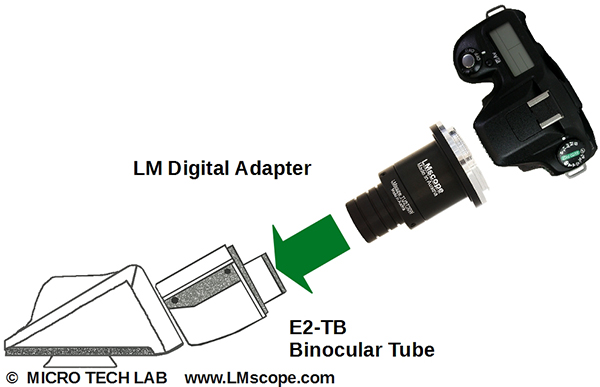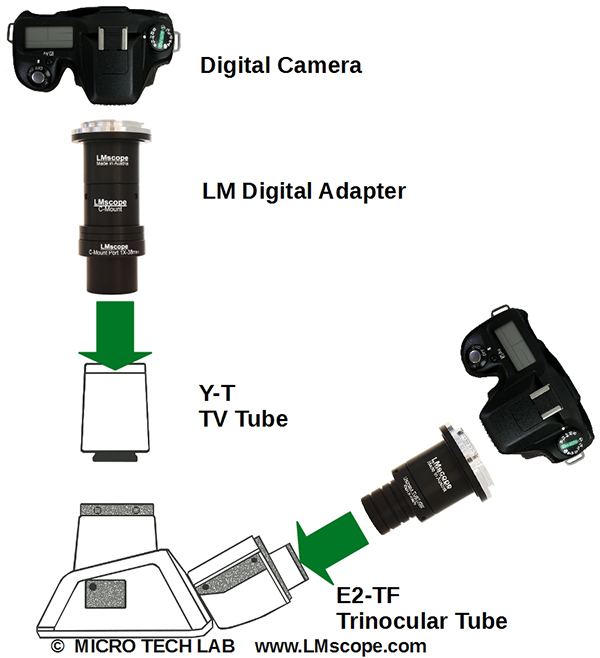

The Nikon Eclipse E200 educational microscope – a cost-effective approach to producing successful images
According to Nikon, the infinity-corrected Eclipse E200 is intended primarily for pathology- and cytology-centred experiments and observations of cells and tissue samples in hospitals and laboratories. Yet the Eclipse E200 has also gained popularity as a student microscope since it features an optional stand for a second eyepiece tube intended for educational purposes and a drawing tube is available as well. The Eclipse E200 is quite favourably priced (used models come in at around € 600 and up), and its low-profile, lightweight design (base weight 7.3 kg) makes it especially suitable for hobby researchers and beginners.

The microscope’s optical system features Nikon’s acclaimed CFI-60 lenses, which offer the combined advantages of relatively large working distances and a high numerical aperture. In addition, its quadruple objective nosepiece is handy and rotates easily. The basic package includes the following plan-achromat objectives: 4x/0.1, 10x/0.25, 40x/0.65 and 100x/1.25. In addition, the Eclipse E200 is also available with a field diaphragm (Eclipse E200-F).
The Nikon Eclipse E200’s standard observation method is bright field. In addition, it can easily be upgraded to accommodate fluorescence applications (epi-fluorescence attachment), while dark field, phase contrast and polarisation are also possible.
A number of ergonomic design aspects make working with the Eclipse E200 particularly comfortable: a rotating binocular tube allows users to adjust not only the tube tilt angle (10º–30º) but also the eyepiece length. In addition, the eyepiece length can be extended by up to 40 mm, and up to two eye level risers can be mounted (2 x 25 mm). The low positioned coarse/fine focus controls ensure accurate focusing, and Nikon's refocussing mechanism is easy to use even for beginners: the low-profile stage can be pushed down with just one hand, which makes exchanging specimen slides or objectives particularly easy. As soon as the hand is removed, the stage returns to its original position.
Beyond the Eclipse E200’s standard 6 volt halogen lamp, Nikon also offers the new Eco LED fly-eye lens. This option guarantees uniform, energy-saving brightness throughout the entire 20 mm field of view.
The Eclipse E200 is designed to resist mould growth. Anti-mould paint combined with an anti-mould agent applied to heavily used areas makes it possible to work even in very humid conditions.
Where photomicrography is concerned, the Nikon Eclipse E200 offers several options, and using our LM digital adapters, digital cameras (DSLRs, mirrorless system cameras with an interchangeable lens mount system, C-mount, USB and firewire cameras) can also be attached to the binocular tube.

The available trinocular tube makes it even easier to work with cameras.

In addition to the original Nikon DS-Fi2-L3 microscope camera with control display, almost any DSLR can be attached to the Eclipse E200 with the help of our tried and tested LM digital adapters.
Photography:
Fitting the microscope to digital single-lens reflex (DSLR), mirrorless interchangeable-lens cameras (MILC ), digital single-lens mirrorless (DSLM) or C-mount cameras is easy with our LM digital SLR adapters, which feature a plan achromatic optical system. Our products make it possible to capture top-quality microscope images. To help you select the adapter that is right for your camera, we have set up an online configurator on our website. You can also email us – ideally with attached photographs of your microscope.
Modern DSLR and single-lens mirrorless (DSLM) offer the latest technology and are generally very well suited for microscopy applications. Most of them can be controlled remotely via PC/Mac. Because of their high sales volumes, they offer an excellent price/performance ratio compared to special-purpose microscope cameras.
Features of top DSLR and single-lens mirrorless cameras (DSLM):
- Large, powerful full-frame sensors (36 x 24 mm)
- Sensor resolution of 61 megapixels or 240 megapixels with Pixel Shift technology
- High light sensitivity (ISO 400,000+)
- Extensive dynamic range (up to 15 aperture stops/f-stops)
- Short exposure times (1/8000 second) up to 1/32,000 seconds using the digital shutter
- 4K Ultra HD or 8K Ultra HD video function
- Live video capture on external monitors in ultra HD quality
In most cases, these cameras are significantly more powerful than microscope cameras with smaller sensors (1/2" or 2/3"). On our website you will find our current camera recommendations and a camera ranking which is specifically tailored to microscopy applications.
New LM Digital Adapter for: Nikon Z9 / Nikon Z8 / Sony Alpha 7R V / Sony Alpha 1 II / Sony Alpha 1 / Sony Alpha 9 II (ILCE-9M2) / Sony FX3 Cinema Line / Sony Alpha 9 / Nikon D6 / Canon EOS R3 / Canon EOS R6 Mark II / Canon EOS R8 / Sony Alpha 7R IV / Canon EOS R5 II / Nikon Z6III / Canon EOS R5 / Sony Alpha 7S II / Sony Alpha 7S III / Sony Alpha 7R III / Canon EOS R6 / Nikon Z6 / Nikon Z6II / Sony Alpha 7R II / Nikon Z7 / Nikon Z7II / Canon EOS R / Canon EOS Ra (Astro) / Nikon Z5 / Sony Alpha 7C / Canon EOS RP / Sony Alpha 7S / Canon EOS R7 / Leica SL2-S / Canon EOS R10 / Nikon Z50 II / Canon EOS 1D X Mark III / Nikon Z50 / Nikon Z30 / Nikon Z fc / Nikon D850 / Canon EOS 1D X Mark II / Nikon D780 / Olympus OM-1 / Sony Alpha 7III / Olympus OM-D E-M1 Mark III / Canon EOS R100 / Sony Alpha 6700 / Nikon D5 / Sony Alpha 6600 / Fujifilm X-H2S / Fujifilm X-S10 / Fujifilm X-E4 / Fujifilm X-Pro3 / Olympus OM-D E-M1X / Sony Alpha 6400 / Sony Alpha 6100 / Sony ZV-E10 / Canon EOS 1D X / Nikon D4s / Olympus OM-D E-M5 III / Canon EOS 90D / Canon EOS 5D Mark IV / Nikon D4 / Nikon D750 / Canon EOS 6D Mark II / Fujifilm X-T5 / Fujifilm X-T4 / Fujifilm X-T3 / Sony Alpha 6300 / Sony Alpha 6500 / Nikon D500 / Nikon D810 / Nikon D800 / Canon EOS M6 Mark II / Nikon D800E / Nikon Df / Panasonic Lumix DC-G9 / Nikon D610 / Nikon D600 / Canon EOS 250D / Canon EOS 850D / Rebel T8i / Canon EOS 6D / Sony Alpha 99 II (SLT-A99 II) / Canon EOS M200 / Canon EOS 5DS R ( without low-pass filter) / Olympus OM-D E-M1 Mark II / Canon EOS 80D / Canon EOS M50 Mark II / Canon EOS 5DS / Canon EOS M50 / Sony Alpha 77 II / Canon EOS 70D / Nikon D7200 / Pentax K-1 Mark II / Canon EOS 200D / Canon EOS 800D / Rebel T7i / Canon EOS 77D / Canon EOS 5D Mark III / Canon EOS 60D / Sony Alpha 7R /